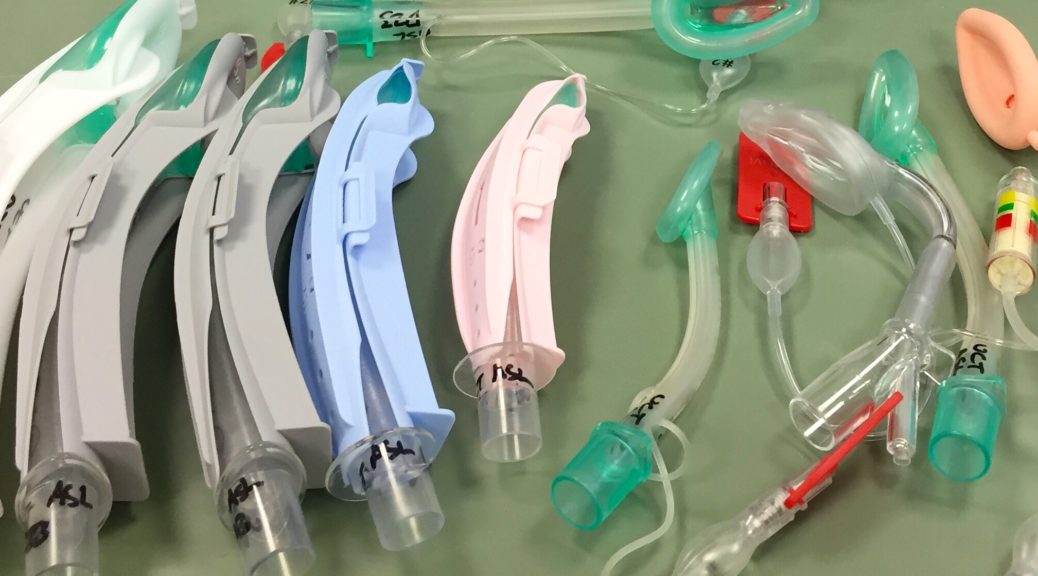Supraglottic Airways
Classification, Generations & Concepts
There is considerable debate in the literature as to how supraglottic airway devices should be classified, with no clear consensus definition. The two major systems proposed describe either the “generation” (Cook classification) or the sealing mechanism with subdivision according to individual attributes (Miller classification). The former is widely quoted in recent literature and guidelines, but lends some confusion in that some second generation devices (eg. Combitube) were invented before the quintessential first generation device, the Classic LMA. A third generation has been proposed for several new devices, but there is not consensus on exactly what attribute makes a device qualify. Miller’s classification is useful from a research and device design perspective, but ideal for day-to-day device selection. Simplified:
Generations (Cook)
- 1st Gen SGA: Simple breathing tube, usually with some form of mask or opening at the larynx. Examples: Classic LMA, LMA-Unique, SureSeal LM, CobraPLA, Laryngeal Tube Airway, etc.
- 2nd Gen SGA: Above, plus provision for gastric drainage and improved protection against aspiration. Examples: Combitube, Proseal LMA, LMA-Supreme, i-gel, LTS-D, AuraGain
- 3rd Gen SGA (proposed): Above, plus incorporates dynamic sealing mechanism. Examples: Baska, Elisha and 3gLM
You can read a good 2011 CEACCP article by Cook and Howes on the various devices and recent advances up to 2011 here (open access). This thinking has been further expanded by Cook to include the concept of adding an “i-” designator if the device is facilitates intubation with a >50% success rate, and “b” or “g” for blind or fibreoptic-guided intubation
Sealing Mechanism (Miller)
- Cuffed perilaryngeal sealers. Examples: LMAs including the ILMA, Air-Q, SureSeal, SoftSeal, etc.
- Cuffed peripharyngeal sealers. Examples: CobraPLA, COPA, PAX, AMD, Elisha, LTA, LTS, Combitube, etc
- Cuffless anatomically preshaped sealers. Examples: SLIPA, i-gel, etc.
There is a nice discussion with some infographics and several comments here on “Dave on Airways.” You can read Cook’s doubts about the need for a 3rd gen classification here, Miller’s response, and further discussion here.
Basics of SGA use
What Concepts are Important?
For the busy practitioner, the most important concepts are:
- What device is going to be quick and easy to use?
- How well is it going to seal?
- Is it going to protect my patient against aspiration?
- Can I use it to intubate through?
Outside of routine anaesthesia and presuming fairly equivalent efficacy at providing basic oxygenation/ventilation, the most important concepts for the prehospital/emergency/critical care provider are protection against aspiration, and then the ability to convert to intubation if required. Increasingly, the routine use of second generation devices is advised in this setting, with the added benefit that most of these devices offer improved sealing pressures as well. Conversion to intubation requires the blind use of a dedicated SGA conduit (eg. Fastrach/ILMA), fibreoptic guidance (direct or using an exchange catheter), or use of a video-equipped intubating SGA (Eg CTrach or TotalTrack VLM).
Here’s a nice overview of concepts from Dr Andy Brainard (@theharpendcrew) of The Sharp End, who also have a great page on supraglottic airways in emergency medicine and some SMACC airway resources, including our page on SGAs. He includes some useful comments on the airQ and ILMA.
Overview of intubating through supraglottic airways:
Intubating through an SGA using a flexible endoscope or fibreoptic bronchoscope
Intubating through an SGA using the Aintree Intubation Catheter
Brimacombe technique for SGA insertion in challenging airway
Minh le Cong in action teaching on SGAs at the #SMACCgold meeting:
Specific Devices and Usage
NB: Videos in the public domain produced by the manufacturers are included below, as they often offer a good overview of the features of the device. Please recognize that OpenAirway does not support or endorse, or receive funding from these companies.
First Generation
Classic LMA
Classic LMA overview and use video:
Classic LMA digital insertion technique with cuff fully deflated:
https://www.youtube.com/watch?v=CjtRlj1Pk3Y
Flexible LMA
Insertion technique (manufacturer video)
Second Generation
Proseal LMA
Proseal insertion (manufacturer video):
Supreme LMA
Product overview and use video from LMA (manufacturer video):
LMA Supreme insertion (manufacturer video):
i-gel
Product overview and use video from Intersurgical (manufacturer video):
airQ
https://www.youtube.com/watch?v=E0a1KYwfDk0
Combitube
Perhaps now retired to medical museums, but you will allow this video to demonstrate the complexity of use…and the glory of the 80’s! (Manufacturer video).
LTS-D
Manufacturer video of the second-generation Laryngeal Tube with gastric draingage.
https://youtu.be/9I2lDgxqCKk
iLTS-D
Manufacturer video of the second-generation Laryngeal Tube which has now been updated to allow endoscopically guided intubaiton.
https://youtu.be/dNR_grMILic
Third Generation
These devices are relatively so new that there is not even complete consensus about what unites them, although the common emerging theme is dynamic sealing. There are only a few studies on each, and some as-yet unpublished research which has been presented (COI: my own Master’s!) Most (if not all) of these devices are designed to act as intubation conduits as well. For the interested early innovators:
- Baska laryngeal mask – commercial site and publication list
- Elisha airway – preliminary study and comments
- 3gLM – pilot evaluation and our work available on request.
Intubating SGAs
Fastrach/ILMA
CTrach
There don’t seem to be a lot of videos out there on the CTrach, but here is a fairly straightforward clinical example:
TotalTrack VLM
TotalTrack VLM
Clinical use video (manufacturer sponsored):
https://www.youtube.com/watch?v=Dwco1z4SooM
Video view using the TotalTrack in a patient with severe OSA:
https://youtu.be/Fjp0WTz2sD4
More information, links to papers and other commentary on the OpenAirway TotalTrack page here.
